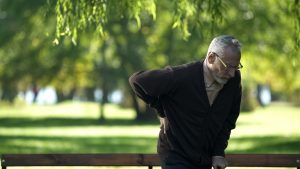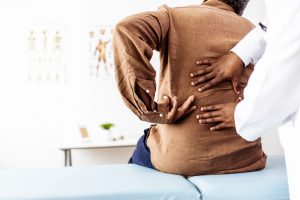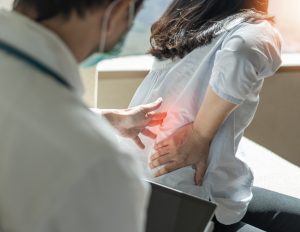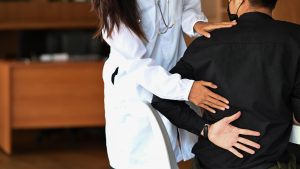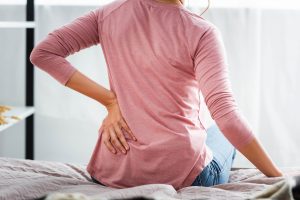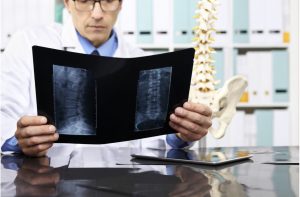Herniated Disc
Chances are you’ve heard of a herniated disc. If you have been diagnosed with a herniated disc, you are likely also familiar with the pain and symptoms often caused by this condition. As you begin to research the treatment options available to help you find pain relief, it’s important to understand what causes a herniated disc to develop in the first place.
Understanding what causes a herniated disc, also referred to as a disc herniation, ruptured disc, or torn disc, is an important step in determining the best treatment options for your condition. For example, a doctor may recommend a different form of treatment for a herniated disc that developed gradually from weight gain as opposed to a herniated disc that developed suddenly from an auto accident. Take time to research this condition so you can be prepared for your appointment with your doctor. At BEST Health System, our caring team is also available to help you learn about your condition and the treatment options we have.
Causes
A herniated disc can result from a number of factors, including:
- The natural aging process – due to the cumulative effects of an aging body and ongoing wear and tear on the spinal components, the disc gradually weakens and becomes more susceptible to rupture.
- Spinal trauma – injuries that result from a forceful blow to the spine can cause immediate disc herniation
- Repetitive stress – sitting for prolonged periods or repeatedly lifting heavy objects can cause a series of small tears to develop in a disc’s outer wall, tears that can worsen over time and lead to full disc herniation
- Unhealthy body weight – the spine must support the majority of the body’s weight, and the pressure of carrying extra pounds, particularly in the abdominal region, can strain and damage the spinal components
- Poor nutrition – an unbalanced diet can lead to weight gain and also deprive the discs of the nutrients needed to remain supple and strong
- Tobacco use – smoking inhibits circulation and interferes with the delivery of essential nutrients throughout the body, including the spine; cigarette smoke also contains a multitude of toxins that can affect the discs as well as other parts of the body
- Genetics – a family history of disc herniation and other degenerative spine conditions can increase the likelihood a person will develop similar conditions
Signs of Herniated Disc
While a herniated disc does not always cause symptoms, the condition can create localized pain if the tear affects the small nerves located in the uppermost layers of the outer wall of the affected disc. Additionally, a variety of uncomfortable symptoms can develop if the disc wall or escaped nucleus pulposus exerts pressure on the spinal cord or spinal nerve root. For instance, some people experience neck and back pain, radiating pain that travels through an arm or leg, muscle weakness, numbness, or walking difficulties.
Closer Look at Symptoms
A herniated disc can conceivably occur in the cervical, thoracic, or lumbar region of the spine, although it is most likely to develop in the cervical and lumbar spine segments. That’s because the neck and lower back are both highly flexible and responsible for supporting significant body weight, which takes its toll over time. The thoracic spine, by comparison, is far more stable because it is attached to the rib cage.
The specific symptoms associated with a herniated disc also depend on the location of the disc degeneration. Most commonly, this condition is associated with localized pain near the origin of the tear in the disc wall, although symptoms can extend throughout the body when displaced disc material irritates or compresses a nearby nerve root or the spinal cord. In fact, when nerve root or spinal cord compression occurs it can result in symptoms that appear far from the origin of the problem, making diagnosis by a physician necessary for effective treatment.
Here are just a few examples of the symptoms that can develop as a result of a herniated disc:
- Cervical herniated disc – localized pain in the neck; pins and needles sensation, muscle weakness and numbness that travel through the shoulders, arms, hands, or fingers; difficulty walking; a feeling of heaviness in the hands and feet; a decline in fine motor skills
- Thoracic herniated disc – upper back pain that can radiate into the chest or stomach; back stiffness and muscle weakness; symptoms caused by a herniated disc in the thoracic spine that can also be incorrectly attributed to a problem with the heart, gastrointestinal tract, or lungs
- Lumbar herniated disc – discomfort in the lower back; pain that travels into the lower body; pain in one or both legs; weakness or tingling in the lower extremities; diminishes reflexes and muscle spasms; in some rare cases a loss of bowel or bladder control, which can indicate cauda equina syndrome, a condition that requires immediate medical attention
The symptoms of a herniated disc can vary widely depending on both the location and severity of the damaged disc and many of the symptoms commonly associated with this condition can also be explained by the presence of additional spinal degradation, including facet disease, spinal stenosis, and spondylolisthesis. In order to effectively manage the symptoms of a herniated disc, the exact cause, location, and severity of the condition have to be identified by a medical professional. If you’ve been diagnosed with a herniated disc and you are considering surgery after exhausting conservative treatments, contact BEST Health System today.
Beginning of Herniated Disc
The spinal column begins at the base of the skill and spans from the cervical spine in the neck through the thoracic spine in the middle back and into the lumbar spine in the lower back. Made up of 24 individual vertebral bodies and several fused vertebrae in the pelvic region, the spinal column is flexible enough to allow for a full range of motion in the neck and back that’s required for daily activity and also strong enough to support the weight of the upper body.
Serving as shock-absorbing cushions for the spine, discs are positioned between adjacent vertebrae to facilitate movement and reduce friction. Each disc has two parts: a thick exterior composed of collagen fiber (annulus fibrosus), which surrounds and contains an inner core of potential gel (nucleus pulposus). These components are high in water content and must remain well hydrated and pliable in order to function properly. For a variety of reasons, the discs can begin to deteriorate and dehydrate over time, becoming brittle and prone to breakage. If a fissure develops in a disc’s annulus fibrosus, some of the nucleus pulposus can pass through its compromised boundary. This condition is referred to as a herniated disc. Pain and other uncomfortable symptoms can develop if displaced inner disc material – which contains inflammatory proteins – irritates or pressures the disc wall, the spinal cord, or nearby nerve root.
Reach out to BEST Health System
If you have experienced any of these symptoms or recieved a diagnosis and need treatment, BEST can help. Take the first step towards relief today.
Related Articles
Living with Herniated Disc Pain
Living with a Herniated Disc Herniated disc pain may be experienced throughout the body, not just in the upper or lower back. Depending on the […]
Common Herniated Disc Symptoms
What is a Herniated Disc? Herniated nucleus pulposus (HNP), more commonly known as a herniated disc or slipped disc, is a common result of the […]
Annular Tear vs. Herniated Disc
What is the Difference? Though very similar, annular tears and herniated discs are two different conditions that can occur due to spinal degeneration. To better […]
Where is Herniated Disc Pain Located?
Herniated Disc Pain Herniated disc pain can be located both locally and in the extremities. Irritation of the nerve endings in the disc wall by […]
Bulging Disc and Herniated Disc - Which is Worse
An Overview of Bulging and Herniated Disc Although a bulging and herniated disc both impact the spinal disc, which cushions the spine and acts as […]
Treating a Herniated Disc with Physical Therapy
What is a Herniated Disc? Herniated disc symptoms include burning pain, numbness, and muscle weakness that radiates out to different parts of the body depending […]
A Guide to Herniated Discs
The different types of herniated discs are named based on their location in the spine. Your spine consists of three main regions: cervical, thoracic, and […]
What is a Laminotomy? | BEST
Patients who have spine conditions that compress nerves in the spinal cord, such as spinal stenosis, herniated discs, and bone spurs, often live with chronic […]
What Is a Herniated Disc and How Does it Develop? | BEST
If you have been diagnosed with a herniated disc, you are likely familiar with the pain and symptoms often caused by this condition. As you […]
Understanding Herniated Disc Symptoms | BEST
Patients with a herniated disc are often surprised to learn that this condition is causing symptoms that can include neck pain, back pain, leg pain, […]
Slipped Disc or Herniated Disc – What’s the Difference | BEST
Whether you call it a slipped disc, slip disc, disc slip, bulging disc, or herniated disc, back pain and other symptoms from any condition related […]
